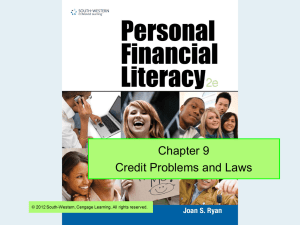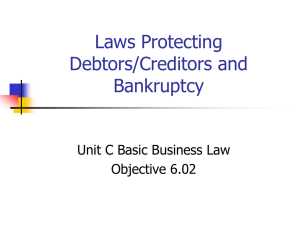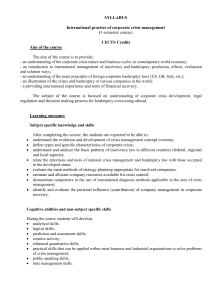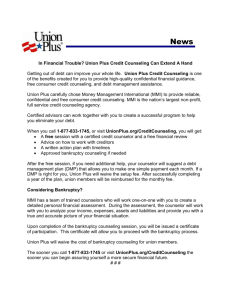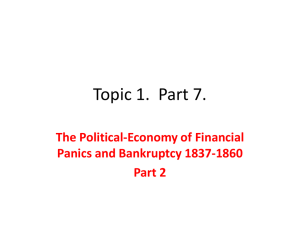Personal Bankruptcy and the Mortgage Crisis
advertisement
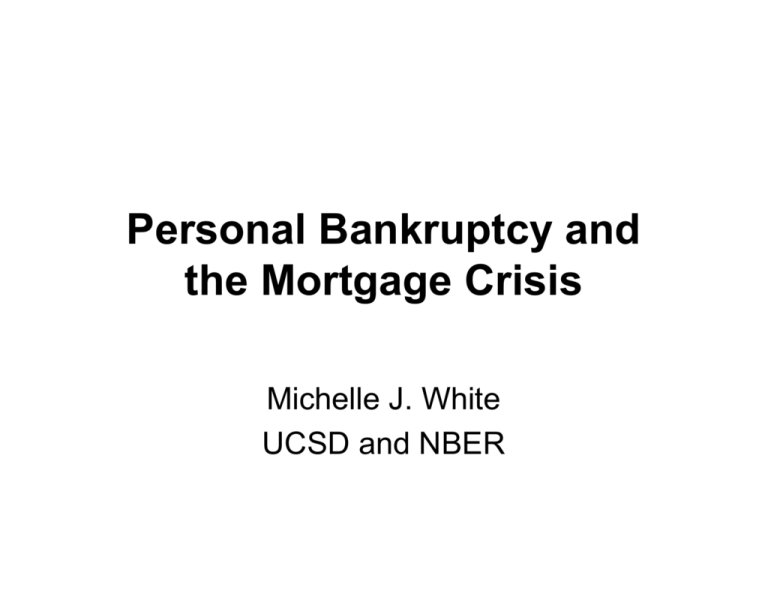
Personal Bankruptcy and the Mortgage Crisis Michelle J. White UCSD and NBER What I’ll talk about: • • • Why have a personal bankruptcy law? US bankruptcy law and changes under the 2005 bankruptcy reform. Can bankruptcy help solve the mortgage crisis? Bankruptcy provides consumption insurance to debtors • Individuals benefit from borrowing, but face risk. • Bankruptcy reduces downside risk by discharging some debt when ability-to-repay falls. • This makes risk-averse debtors better off. • States with higher exemptions provide more complete consumption insurance. Bankruptcy encourages entrepreneurship • Risk-averse individuals are more willing to start businesses if the cost of failure is lower. • Evidence shows that states with more generous bankruptcy exemptions have more entrepreneurs. But a generous bankruptcy law: • reduces credit availability/raises interest rates This applies to: – Consumer credit – Small business credit – Credit to small corporations • encourages opportunistic behavior US Personal Bankruptcy Law • Two procedures—Chapters 7 and 13 Chapter 7 • Unsecured debt is discharged. • Debtors must use assets above an exemption to repay. • All future income is exempt. • Some states have high homestead exemptions—in these states debtors can keep high income and high assets. • Prior to 2005, 70% of filings were Ch 7. Chapter 13 • Unsecured debt is discharged. • Debtors must use some future income to repay debt for 3-5 years. • All assets are exempt. • Ch 13 mainly used by debtors to save their houses or cars (mortgages and car loans aren’t discharged in bankruptcy). Sounds pretty favorable to debtors… Bankruptcy filings rose 5-fold from 1980-2005 bankruptcy filings 2500000 2000000 1500000 bankruptcy filings 1000000 500000 19 80 19 83 19 86 19 89 19 92 19 95 19 98 20 01 20 04 0 But pro-debtor bankruptcy law doesn’t explain the rise in filings. What does? Consumer and mortgage debt /median income, 1980-2005 4.5 4 3.5 3 consumer debt /median income 2.5 2 mortgage debt/ median income 1.5 1 0.5 2004 2002 2000 1998 1996 1994 1992 1990 1988 1986 1984 1982 1980 0 Rising Debt Relative to Income Consumer debt/ median Income Mortgage debt/ median income 1980 3% 2005 13% 56% 150% Lenders lobbied heavily for bankruptcy reform— What did they get? • New “means test” forces high-income debtors to file under Chapter 13 and repay some unsecured debt (not very strict). • Higher bankruptcy costs discourage all debtors from filing. Effects of the 2005 reforms • Filings fell from 2 million in 2005 to 600,000 in 2006, but rose to 800,000 in 2007. • Higher debt: Consumer debt/HH rose 13% and mortgage debt/HH rose 16% from 2005-07. • Lower charge-off rate on credit card loans. • More Ch 13 bankruptcies. How does bankruptcy help debtors save their homes? Homeowners and Ch 7 Ch 7 helps homeowners because credit card debt is discharged, so paying the mortgage is easier. • But Ch 7 doesn’t stop foreclosure. • Since 2005, some debtors can’t pass the means test for Ch 7. • Homestead exemption is capped at $125,000 if debtors moved in the past 3.5 years. Homeowners and Ch 13 Stops foreclosure and allows debtors to repay mortgage arrears over 5 years under a repayment plan. • Most unsecured debt is discharged b/c mortgage is paid first. • But no mortgage forgiveness in bankruptcy. • Not changed in 2005. How are debtors using Chapter 13? Repay unsecured debt or save their homes? Debtors are using Chapter 13 to save their homes/cars • In a 2006 sample, 96% of Ch 13 filers were homeowners. • 78% passed the means test, so they could have filed under Ch 7. • What debtors repaid in Ch 13 plans: -- 78% repaid mortgages. -- 45% repaid car loans. -- only 9% repaid just unsecured debt. • But Ch 13 doesn’t help the mortgage crisis. Bankruptcy and The Mortgage Crisis • 2.7 million foreclosures occurred in 2007 and 2008; 2 million more to come. • Foreclosures have very high costs: – – – – Owners lose since they must move; Some become homeless; Lenders lose 1/2 of loan value; Neighborhoods harmed because vacancies cause blight/disease; – Cities lose property tax revenue. • Foreclosures lead to yet more foreclosures… Solutions 1: renegotiate mortgage contracts • Avoiding foreclosure is in both sides’ interest. • But little renegotiation has occurred—why? – Most mortgages are in securities that limit or prohibit changes in financial terms. – Mortgage servicers fear liability if they renegotiate. – Servicers are paid for foreclosing, not renegotiating. – Second mortgage-holders can block refinancing of first mortgages. – Private mortgage holders prefer foreclosure. Solutions 2: Government programs • “Hope Now” – program to encourage voluntary renegotiation. It did little. • “Hope for Homeowners” passed July 2008. – – – Government will issue new mortgages. Program requires old lenders to consent. This means adverse selection (large losses for government) and tough bargaining by lenders (some worthwhile refinancing won’t occur). Solutions 3: Bankruptcy approach • Allow bankruptcy judges to “strip-down” mortgages in bankruptcy. • Divide mortgage into: – secured part = current market value and – unsecured part = the remainder. The unsecured part could be discharged or partially repaid, like other unsecured debt. Solutions 3: cont. • Judges could also: – Reduce the principle or interest rate. – Discharge excessive fees. • Lenders’ consent not required, so no renegotiation problem and no adverse selection. • Bankruptcy trustees could spot opportunism since bankruptcy requires extensive documentation. Solutions 3: cont. Possible drawbacks: • • Mortgage interest rates might rise? Reduced supply of credit card loans because more would be discharged. Bankruptcy approach provides an alternate route for debtors if: • • lenders refuse their consent or government programs run out of money.
